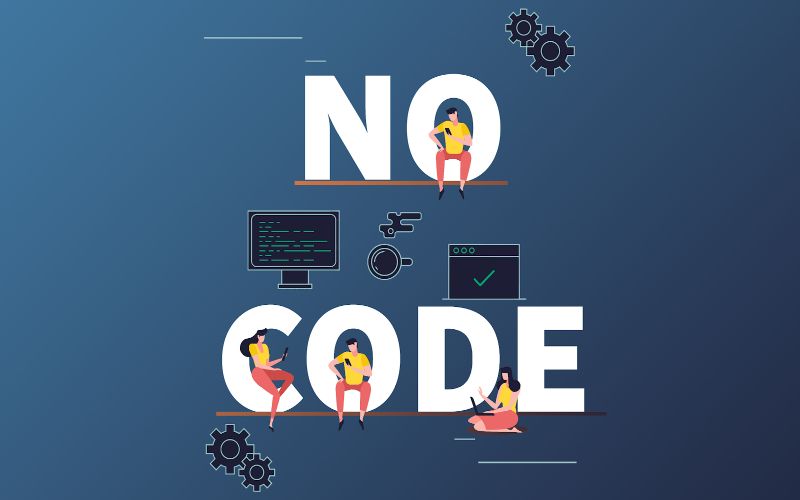Introduction
A new generation of no-code platforms is changing the way software is made available to people and businesses, giving them the ability to develop applications with lesser coding skills. No-code development involves creating, developing, and deploying applications within easy-to-use visual interfaces, thereby minimizing the time and costs incurred. With evolved technology, no-code becomes an increasingly important factor for organizations that want to innovate rapidly and effectively.
The Rise of No-Code Platforms

This is the Rise of No-Code Platforms because they are to find huge popularity and demand among the people as new windows in industries are emerging over digital solutions. By utilizing Bubble, Adalo, and Webflow, entrepreneurs, startups, and businesses can create apps without reliance upon conventional programming capabilities. The No-Code Platforms come with drag-and-drop capabilities, pre-made templates, and automated tools to help make software development easier than ever.
The reasons for the growing trend towards no-code can be summed up as follows:
Cost-Effectiveness: App development costs might come down alongside hiring developers and maintaining a tech team. Businesses can create apps almost at a fraction of the cost; thus, no code eliminates this requirement.
Speed of Development: Applying coding old-school would sometimes take weeks or even months to develop an application. The no-code path diminishes such development time to the point that businesses can push out for faster releases.
Accessibility: With no code, an app can much more easily be created by business people, marketers, or entrepreneurs without technology.
Scalability: Most no-code platforms provide scalable expandability so that their applications can be developed and improved according to changing business needs.
How No-Code is Changing Traditional Development
No code would introduce disruption into the old-fashioned software development process in democratizing the actual app-making. Earlier, to make software, it had to be done by hiring experienced developers, writing thousands of lines of code, and through lengthy procedures of testing. No-code would simplify this into extending applications through visual programming interfaces pretty easily for even those who are technically not inclined to develop applications.
Some of the dynamic ways by which no code is transforming the traditional way of development include:
- Reduction dependency on developers- large businesses do not need more employees in the development department to make their applications.
- Fast prototyping- the start-ups are able to try quickly sufficing their ideas and use anything functional prototype without spending money on development resources.
- Bridging different teams to work together- no-code platforms let different teams, such as marketing, sales, and operations, have their voice heard directly by app owners.
- Bridging talent gaps– Companies struggle actively today with the scarcity of developers. No-code helps companies offset these by enabling non-programmers to build applications.
Industries Benefiting from No-Code
No-code intersects a range of areas and hence is helping industries make use of these to improve internal operations, automate workflows, and enable the fast launch of digital products. These include:
E-commerce: no-code platforms help businesses set up online stores to manage inventory and integrate available payment systems without developing one.
Healthcare: A lot of clinics and health centers have explored no-code to develop patient portals, appointment booking systems, and telemedicine platforms.
Finance and Banking: Automating processes in financial institutions, developing customer portals, and building custom CRMs, all of which are possible through no-code solutions.
Education: No-code platforms are mostly used by schools or universities in developing learning management systems and enabling online platforms for courses.
Real Estate: the no-code solution allows the real estate professional to create a property listing website, automate client interaction, and manage leads easily.
The Role of AI in No-Code Development
The role of artificial intelligence in regaining thrust onto no-code development hardly can be exaggerated. Some brand-new AI-agnostic features that boost user-friendliness for the development phases of the app would include:
- Automated code generation: AI would observe the user input stated and suggest the most optimized backend code, thus saving the user from the coziness.
- Smart suggestions: AI-based suggestions guide users to select the most suitable templates, workflows, and integrations for their projects.
- Natural Language Processing (NLP): Some no-code platforms allow users to verbally express in common terms what they would like to have. The AI then translates those in layman’s terms into a fully functional application.
- Predictive Analytics: AI insights can help users to be sure that they are performing educated optimization and performance decisions for their apps.
Thus, with technological advancement in no-code applications, AI will facilitate the enhancement of such platforms that allow low-energy capabilities for creating complex applications.
Challenges and Limitations
Yet, despite all the advantages of no-code development, challenges still exist for the development of the project.
- Restrained customization: No-code platforms come with ready-made functionalities, where coding may be required for really difficult custom apps.
- Security concerns: Organizations should ensure that the no-code platform they are using complies with all data security and privacy regulations.
- Platform lock-in: In most cases, users are locked into one specific no-code platform, and thus lose flexibility in changing tools.
These challenges exist but a lot of the advances in the technology of no-code are finding their way to resolving most of these issues, thereby guaranteeing that it serves as an increasingly favourable approach for businesses of all sizes.
Conclusion
It is reshaping a future for app-making that is accessible and efficient and cuts costs. The development of AI-powered no-code platforms can build advanced applications, and none of the members have an extensive programming knowledge branch. While there are certain challenges, the pros of no-code easily surpass those few cons, making it a revolutionizing phenomenon for global industries.
Tentoro, a new rising no-code platform, symbolizes the change by providing a simple-to-use tool that empowers the user to create a powerful application without the need to know to code. Tentoro brings the next generation of no-code development, packed with a user-friendly interface, automation, and AI capabilities. As the requirement for digital solutions increases, platforms like Tentoro will democratize the app development process and innovation in all industries.

